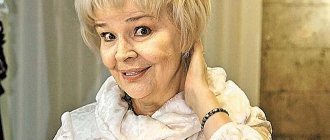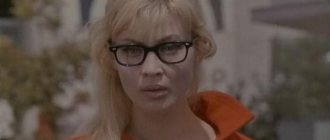In March 1931, a wonderful pop singer, our Soviet Edith Piaf, and People's Artist of Russia Tamara Miansarova were born in Ukraine. Her biography began in a creative family. My parents were gifted people, in any case, they always sang there. Her father is a theater artist, an artist, her mother is a simple factory worker, but actively participated in amateur performances. Once she won a vocal competition, where her talent was noticed and appreciated - then she sang at the Minsk Opera House. There the war found this family.
Biography
Tamara was not Miansarova yet; her maiden name was Remneva. She first appeared on the big stage at the age of four and was immediately successful. She studied very well, showed excellent abilities as a pianist, graduated from a ten-year music school in Minsk and in 1951 entered the piano department of the Moscow Conservatory. You can imagine the environment Tamara Miansarova immediately found herself in! From the very beginning, her biography was enriched with exceptionally interesting surroundings. During these years, piano was taught at the Moscow Conservatory by Neuhaus, Goldenweiser, Shebalin, Sofronitsky... It is impossible to list them all, but it is even difficult to find a name that would sound brighter than others. And it was not just anyone who took her into his class, but Lev Oborin himself!
There, at the conservatory, her last name changed to the one that is now known to everyone, and everyone associates it with the sound of the wonderful voice of Tamara Miansarova. Her biography was now built purposefully and quickly. It must be said that she played the piano very well, but the man whose last name Tamara bore until her last hour did it even better. Eduard Miansarov is one of Lev Oborin’s many outstanding students (he simply didn’t have any outstanding ones!), a very significant pianist: fourth prize at the First (and largest in the world) Tchaikovsky Competition in Moscow. First place - Van Cliburn, and fourth - Eduard Miansarov. But Tamara glorified his surname even more when she started singing.
early years
Tamara Grigorievna had a maiden name of Remneva, was born in the Ukrainian city of Zinovievsk (now Kropivnitsky). Her father was a theater actor and singer, and left the family after the birth of his daughter. Mother Anastasia Fedorovna was also a creative person.
Tamara's childhood was quite difficult; her mother barely managed to feed her family. Her mother and relatives instilled a love for song in the girl. Already at the age of four she made her debut on stage. Her childhood years were overshadowed by wartime; after the end of the war, Tamara suffered from tuberculosis and underwent long-term treatment. Tamara's mother had to endure injury and three years of exile.
After the mother returned from Siberia, the family settled in Minsk. Anastasia Fedorovna got a job at a local radio, and Tamara began attending a school for talented children at the conservatory. After graduating, the girl decided to enter the Moscow Conservatory, but met serious resistance from Belarusian teachers. They didn't even give her documents. But Tamara, not succumbing to obstacles, went to Moscow in 1951, where she presented a poster about her performance.
Child photo of T.G. Miansarova
Having proven her abilities in practice, she easily passed the entrance tests, and Moscow has already requested documents about graduating from school. She studied at the piano department, combining with classes at the vocal department.
Vocals
In 1957, Tamara graduated from the vocal department of the Moscow Conservatory, after which she began working as an accompanist at GITIS. At the same time, I was searching for myself and my niche in art. And a year later such an opportunity presented itself: singer Tamara Miansarova took third place at the All-Union Variety Artists Competition. Her biography is now filled with completely different events, different meetings, different music. They began traveling around the country with concerts, began working at the Music Hall, where Tamara especially distinguished herself in the solo part in the play “When the Stars Light Up.”
Of course, family and children were important to her. Tamara Miansarova did not deplete her biography in any way. In 1956, his son Andrei was born, who became an excellent musician, a brilliant arranger, who worked with the best instrumental ensembles and soloists in the country (including VIA Gems), and even made arrangements for his mother and arranged recordings with the best musicians in the best studios ).
New stage
In the same 1958, Tamara began singing jazz in Igor Granov’s quartet - another new line in her biography. The family and children saw Tamara Miansarova less and less. Success awaited her everywhere - a graceful beauty with a naturally beautiful, and even trained voice through a double conservatory education, with an exceptionally strong desire to sing, she could not help but be remembered by the audience.
The singer was becoming famous: one only has to remember how quickly Tamara Miansarova’s photos sold out. Children, personal life - the singer’s biography should have pushed all this into the background. And so it happened. It’s good that my grandmother helped raise her son Andrei and daughter Ekaterina. The children had to understand how great their mother’s talent was. Not to meet him halfway is a disaster and betrayal. What God gives to people must be returned a hundredfold. Tamara did it too.
Family
With the beginning of a new stage in the biography of Tamara Miansarova, the family was really forced to go into the shadows of her victories, which literally followed each other, and each was more significant than the previous one. So imperceptibly, Eduard Miansarov first went into the shadows, and then completely, leaving his wife only his last name, to which Tamara brought even more fame.
Eduard's son Andrei is still extremely attached to his father and, judging by the interview, this long-ago separation still hurts him. Well, Tamara Miansarova should have made her own biography! Nationality, age or marital status can neither help nor hinder anyone in such cases.
Curious public
Many are now interested not so much in the singer’s work as in her personal life. They also ask about nationality (most often by those who know nothing about the singer, including the fact that as a girl she bore an absolutely Russian surname - Remneva). But it would be better to turn on old recordings and enjoy her magnificent voice once again, shed tears with the song “Eyes on the Sand”, be moved by “The Baby Stomps”, be surprised that the first performer of the still popular song “Black Cat” was Tamara Miansarova, yes and it was sung much better than all the modern celebrities who included it in their repertoire.
And then, starting in 1958, one tour followed another. Tamara's march through the Soviet Union was truly triumphant. Everyone has their own path in life, their biographies are different - some are loud, some are quiet. How can you feel if you hear your own voice from every window, and fans are literally tearing your photo out of each other’s hands? The biography of Tamara Miansarova, the family - children and adults - also fell into this whirlwind, and who, if not they, were the first to feel that fame has a burden, and it is heavy.
Festivals
At the World Festival in Helsinki (1962), the delegation of our artists made a huge impression, and the song “Ai-lyuli” by composer Lyudmila Lyadova worthily adorned the biography of Tamara Miansarova. Her photos appeared in the press all over the world. The festival jury, the hearts of spectators and listeners were conquered. Tamara received a gold medal and first prize.
And in 1963, a year later, at the International Song Festival in Sopot, Tamara Miansarova created a real sensation, which only Alla Pugacheva could repeat many years later. For the first time, the composer Ostrovsky’s song “Let there always be sunshine” was performed here. Maya Kristalinskaya sang it first, but the song gained real fame after Tamara Miansarova performed it.
Pop singer career
In 1958, at the III All-Union Competition of Variety Artists, Miansarova received third prize. Then she performs in concerts. He performs as a soloist at the Music Hall in the play “When the Stars Light Up.”
The leader of the jazz quartet, Igor Granov, was looking for a soloist in 1958. The beautiful Tamara, with a unique voice, a higher conservatory education (in fact, two) and a desire to sing, could not go unnoticed. And she began performing with a quartet.
And since 1958, a new stage in the singer’s life begins. Now the interesting facts of her victories are lined up one after another. There will be a triumphal march through the Soviet Union and a number of countries (it will be especially loved in Poland). Miansarova’s songs will sound from every open window; the song “Eyes on the Sand” will make more than one fan of her talent cry.
In 1962, the team, as part of a delegation of Soviet artists, went to the VIII World Festival of Youth and Students in Helsinki. And the song “Ay-lyuli” by L. Lyadova and B. Bryansky, performed by Tamara Miansarova, so touched the hearts of the audience and the jury that the singer received first prize and a gold medal.
A year later, in 1963, Miansarova went to Sopot, to the International Song Festival, long before she captivated the public there. And here she became the winner. She sang “The Circle of the Sun” so that the audience felt everything that could be expressed with this song: the fear of a little girl who found herself amid the horror of occupied Minsk, and the desire of people for peace, and the desire for happiness for every person, regardless of faith, nationality and citizenship. From that moment on, Miansarova became an idol of Polish listeners, starred in a musical film, gave concerts, recorded discs, and the song turned into her calling card.
Since 1964, Tamara Miansarova has been a popular performer in the Soviet Union. For her, the group “Three Plus Two” was assembled by Leonid Garin. She is greeted with delight, the photos are sold out instantly. She sings in the New Year's programs "Blue Light".
And again, Polish fame from Sopot warmed Miansarova with its rays - the song “Ryzhik” (a cover version of the Polish song “Rudy rydz” by Helena Majdanets) became super popular in our country. And a year later, “Black Cat” appeared (Authors: Yu. Saulsky and).
"Sunny Circle"
This was an extremely interesting interpretation. The audience deeply felt everything: the collapsed world and the horror of the occupation in the perception of a small child, his fear, his defenselessness and such great kindness, the ability to give happiness to every person - at least drawn. It is this performance that can be called the calling card of both the song and Tamara Miansarova herself. In Poland, the singer instantly became an idol: she was cast in a musical film, recorded several CDs, and was constantly invited on tour.
In her homeland, they also waited for her everywhere, loved her everywhere. Children and personal life were, of course, included from the very beginning in Tamara Miansarova’s biography, but she simply physically could not pay much attention to all this. One after another, her songs became hits: “Ryzhik” (version of a Polish song), “Black Cat”, “Let’s never quarrel”. In 1966, a song marathon took place across socialist countries: Poland, Bulgaria, Hungary, Czechoslovakia, the GDR and the USSR hosted singers in turn, and in each country there was a tour with a local national song. Tamara Miansarova won four out of six rounds and, of course, won this difficult marathon.
Decline of a career
In 1966, a song festival was held among 6 socialist countries of Europe. The USSR, East Germany, Czechoslovakia, Hungary, Bulgaria and Poland hosted singers, in each country there was a tour with a song from that country. Tamara Miansarova won 4 out of 6 rounds and turned out to be the winner of this musical marathon. This continues until 1970. And then they simply stopped inviting her on air, to concerts, and there was an unspoken ban on Miansarova, as sometimes happened with artists.
Tamara Miansarova | Official site
The year 1970 brought complete disappointment. According to Miansarova herself, her career was ruined by one high-ranking official who constantly persecuted her to no avail. There were no concerts, songs disappeared from radio and TV. Miansarova was forced to resign from the Mosconcert and leave Moscow. Next was the Donetsk Philharmonic. 12 years of traveling with concerts around Ukraine. Tamara Miansarova sang in many mining towns, and in 1972 she received the title of Honored Artist of the Ukrainian SSR.
Tamara Miansarova | Official site
Having returned in the 1980s, the singer, who was carried in her arms and cried from the sound of her living voice and artistic performance of each song, was no longer able to rise to her previous heights, but even now she is loved and listened to with pleasure in our country. By this time, a film about the singer in her youth was shot in Kyiv, and in Poland, Panorama magazine announced the 4 most popular singers in 25 years. They were Aznavour, Piaf, Gott and Miansarova.
Tamara Miansarova | Official site
However, in the homeland, the former brilliance and popularity no longer happened. There were concerts, but much fewer than before. Miansarova taught vocals to students at GITIS, was invited to serve on the jury of competitions, participated in programs dedicated to retro music, received the title of People's Artist of Russia in 1996, and wrote a book.
In 2020 she celebrated her 85th birthday.
Donetsk
In 1970, Tamara’s career seemed to collapse from a great height. She was no longer invited to the New Year's “Blue Lights”, and indeed on the air, concerts became rare. This sometimes happened with artists, as if an unspoken ban had come from somewhere. The singer subsequently said that one of the top echelon officials did not get the desired result in her claims, hence the reaction. Songs performed by Miansarova were swept out of television and radio programs like a broom; she had to resign from the Mosconcert, and even had to leave the capital.
In Donetsk, Tamara got a job at the Philharmonic and toured only around Ukraine. The miners continued to love her. Even at BAM she visited exactly the village that was built by the Ukrainian SSR. The concert was sold out, and, listening to the half-forgotten hit “Eyes on the Sand,” many women openly cried. And then Tamara gave a gift to the builders: she performed a song that was written by local musicians, and which she learned literally an hour before the concert. The orchestra turned out to be so professional that they also joined in immediately. The song was about a village near Komsomolsk-on-Amur named Urgal. The ovation did not stop for a very long time, and the audience is still grateful to Tamara Miansarova. This was in the late 70s, and a little earlier the singer was awarded the title of Honored Artist of the Ukrainian SSR.
"Black Cat" crossed the path of the legendary Tamara Miansarova
Today, People's Artist of Russia Tamara Miansarova turns 84. It was she who sang the once mega-popular songs - “Let there always be sunshine”, “Black Cat”, “Top-top, the baby is stomping”, “Let’s never quarrel”, “Rudy-ryds”, “Eyes on the sand”... List of hits The legendary singer can continue for a long time - her repertoire includes 140 compositions!
And who would have thought that Tamara Grigorievna would spend her old age in need? Forgotten and abandoned by everyone. Even with her own children... The Soviet pop star celebrates her 84th birthday only with her husband, Mark Feldman. The singer is sick, but the pension of both spouses is not enough for treatment. The artist’s deplorable condition became known from actress Alika Smekhova (Tamara Grigorievna once taught her vocals).
“The once brilliant and popular singer lives on the brink of poverty,” Smekhova wrote on her Facebook on the eve of the elderly artist’s birthday. - Friends! If you remember the songs performed by Miansarova (...) and you have the desire and opportunity to provide any assistance to the legendary singer, you can call Mark Mikhailovich on the phone - 89032358575. You will be very grateful for any help and attention!
Facebook of Alika Smekhova
TEN FACTS ABOUT TAMAR MIANSAROVA
1) Tamara Grigorievna was born on March 5, 1931 in the Ukrainian city of Kirovograd. His father abandoned him and his mother when Toma was only six months old. The future artist’s mother wanted to drop her off at the orphanage because she didn’t know how to feed the baby herself. But she couldn’t do it... Then Tamara’s mother was hired to work as a soloist on the radio in Minsk. It was there that the girl survived the war.
“We fed ourselves by alms. And at night, my mother knitted two-fingered mittens for the partisans to make it easier to shoot. I helped her. We made 2 - 3 pairs a week. For this we were given bread or some other food. So they turned over,” Miansarova recalled in an interview with Express Newspaper.
2) While studying at the conservatory, Tamara married pianist Edik Miansarov. She still bears his last name. The couple did not live long in marriage. But the singer had a child from her first husband, Andrei Miansarov.
“When he found out that I was expecting a child, he abandoned me. We were still studying at the conservatory then and living in a dormitory,” Tamara Grigorievna said in an interview.
3) In 1957, the artist graduated from the Moscow Conservatory. She was sent to work at GITIS as an accompanist. But soon the girl decided that the stage was closer to her. She began performing solo concerts. And also participate in various competitions. And win them! Thus began her path to all-Union glory.
4) The apogee of the singer’s popularity came in 1963, when she won the International Song Festival in Sopot, Poland, with the song “Sunny Circle” (“Let there always be sunshine”). This song became her calling card. In the press, Miansarova was called “the nightingale of Moscow.”
In 1966, Miansarova won the “Friendship” pop song competition of socialist countries. Photo: RIA Novosti
4) Until 1970, Miansarova successfully worked at Mosconcert. But she had the misfortune of falling out of favor with an influential person in the Ministry of Culture. So she became “restricted to travel,” and the singer’s performances disappeared from television screens and radio stations.
5) Tamara Grigorievna was forced to leave Mosconcert. She moved to Donetsk. And she worked at the local philharmonic for 12 years.
6) At this time, the singer was married to Igor Khlebnikov, the administrator of her team. From him Miansarova had a daughter, Ekaterina.
- Earned easy money. But I didn’t spend anything on my daughter and family,” the artist shared in an interview with Express Newspaper. — He constantly organized parties at home and drank heavily. And when he got drunk, he beat me brutally.
In the 1960s, wherever Miansarova performed, the halls were always crowded. Photo: RIA Novosti
7) In the 1980s, Miansarova returned to Moscow. Then she married violinist Mark Feldman. They have been together for over 35 years!
“Mark is my main support in life,” the artist said in all interviews.
 In the Russian capital, the singer taught vocals at GITIS and at the Taganka Youth Arts Center from 1988 to 1996. Then she retired.
In the Russian capital, the singer taught vocals at GITIS and at the Taganka Youth Arts Center from 1988 to 1996. Then she retired.
9) Miansarova has two honorary awards. She is an Honored Artist of the Ukrainian SSR (1972) and People's Artist of Russia (1996).
In total, Tamara Miansarova’s repertoire includes more than 140 songs. Photo: RIA Novosti
10) In 2012, a scandal broke out. In one of the television programs, the singer’s son Andrei Miansarov spoke unflatteringly about his mother and especially about her new husband, Mark Feldman. In response, Tamara Grigorievna said in an interview that her son left her without a dacha, a car and money.
In addition to two children, the singer has three grandchildren. One of them is a famous DJ. According to Miansarova, neither her children nor her grandchildren help her.
FIVE MOST FAMOUS SONGS OF TAMARA MIANSAROVA
1) “Let’s never quarrel”
Tamara Miansarova - Let's never quarrel. Tamara Miansarova - Let's never quarrel
2) “May there always be sunshine”
Tamara Miansarova May there always be sunshine. Recording from a Polish television broadcast. 60s. Music - A. Ostrovsky, words - L. Oshanin. Many thanks to Polish friend Leszek Orkisz for this video.
3) “Golden Key”
Tamara Miansarova - Golden Key. "Golden key" Japanese song. Russian text - I. Shaferan. Tamara Miansarova sings, accompanied by the ensemble directed by E. Dergunov. Song from a musical film...
4) "Ryzhik"
Tamara Miansarova - Ryzhik. Tamara Miansarova - Ryzhik. Yes-and-what voices,... 60-tniki!:)
5) "Black Cat"
Tamara Miansarova Black cat. Recording from the anniversary concert of Tamara Miansarova. 2005 Music - Y. Saulsky, words - M. Tanich.
Moscow
In the eighties, Tamara Miansarova returned to Moscow. It was no longer possible to rise to the previous popularity. The listeners no longer carried it in their arms, although both artistic and singing skills had grown significantly. However, there were music lovers who listened to Miansarova and will always listen, since her magical voice, her mesmerizing manner of singing, her style have not disappeared anywhere. She is a master, and therefore will forever remain in the history of Soviet and Russian pop music.
At the same time (in the 80s) in Ukraine they missed her: they made a film about the youth of Tamara Miansarova, and songs performed by her were constantly broadcast. And in Poland it was even more interesting. Panorama magazine collected readers' opinions on the most popular singers over the last quarter century. Miansarova shared first place with the Beatles, Edith Piaf, Aznavour and Karel Gott were nearby. And Tamara Miansarova simply taught vocals (again at GITIS), sometimes “judged” competitions, and a little less often participated in any programs, mainly dedicated to retro music. And she wrote a book of memoirs (although it’s too early, she should shine more!). In 1996, she was awarded the title of People's Artist of Russia.
Singer career
After graduating from the conservatory, Remneva worked as an accompanist. And I dreamed of a big stage.
In 1958, her dream came true: she received third prize at the III All-Union Competition of Variety Artists. After this, her concert activity began, performances at the Music Hall, and then in a quartet.
It was 1958, and Igor Granov was just looking for a soloist for his jazz quartet. When he heard Miansarova, he realized that he had found exactly the voice and the image that he was looking for. Education, charm, magnificent voice, plasticity - everything about her was to the highest degree.
It was in 1958 that her career began to take off: triumphant performances in the Soviet Union, friendly countries, broadcasts on radio and television, and the love of the public.
In 1962 - performance at the youth festival in Helsinki, award and gold medal. A year later, Miansarova becomes the winner of the International Festival in Sopot.
Her songs “Eyes on the Sand”, “Ai-lyuli”, “Sunny Circle”, “Ryzhik”, “Black Cat” won the hearts of millions. The artist recorded records, and they flew around the world, delighting the hearts of listeners. As recognition of talent - the title of People's Artist of Russia.
The group “Three Plus Two” was created especially for Miansarova, which is met everywhere by enthusiastic fans, photos of the artist in Soyuzpechat kiosks are sold out instantly, she became a regular guest of “Blue Light” - the most popular New Year’s program in the USSR.
This was the case until 1970, and then the singer suddenly disappeared from everywhere and stopped performing concerts. According to rumors, the official is to blame for this, to whom Tamara did not reciprocate. She went to Donetsk, sang in Ukrainian cities, where she was awarded the title of Honored Artist of the Ukrainian SSR.
Tamara Grigorievna returned in the 80s, when everything had changed, but the time was already different, other stars shone in the pop sky. Miansarova taught at GITIS, participated in the jury of competitions, and sang in programs about retro music.
Personal life
The singer’s life was stormy in all respects, including her personal life; she colorfully wrote about this in her own book. Several marriages, children - the biography of Tamara Miansarova included everything. A little less than two years ago, her eighty-fifth anniversary passed in the most modest way, that is, almost unnoticed. Even son Andrei did not come to congratulate.
He remembers all his mother’s husbands well, but could not find a common language with the last one. That is why family relationships remained unenviable. But it is possible (even certain!) that the misunderstanding began much earlier. From endless tours. From rejection of choice when my son decided to get married. And this rejection automatically transferred to the grandchildren who appeared. And again with rejection of choice when the son decided to remarry. But the son turned out to be worthy of his parents in character and defended his choice. His half-sister (mother’s third marriage - with Igor Khlebnikov, an administrator) also does not visit Tamara Miansarova very often. She also has a reason: constant illness after an accident that Ekaterina had many years ago.
Disease
I don’t really want to write about the fact that the singer’s friends, children, grandchildren, and neighbors willingly attended television programs like “Let Them Talk,” where they gossiped verbosely, at length, and in some places shamelessly about each other. Meanwhile, Tamara Miansarova could not walk after a hip fracture, gradually became blind and needed not only attention, but also the most necessary material things. It was charities that helped, not two children or three grandchildren.
It’s better to remember how her most famous hits were born. Tamara caught foreign melodies on the radio, writing them down in a notebook (real musicians can do this!), and then ordered poems from poets. This is how Leonid Derbenev established himself on the national stage. And Tamara Miansarova began to sing songs such as “Letka-Enka” and “Charleston”. She also performed her own music: “Hands”, “My Russia”. The repertoire of the Soviet stage was indeed rather meager.
Tamara Miansarova’s husband: “Sadalsky is a scumbag”
Tamara Miansarova // Photo: Artist’s website
Late in the evening of July 12, singer Tamara Miansarova passed away. Shortly before this, she was hospitalized with pneumonia. The sad news was reported by the artist’s common-law husband Mark Feldman.
Actor Stanislav Sadalsky expressed his opinion about what happened. He said that Miansarova’s partner was only interested in money. Despite the fact that harmony reigned in the couple, for 40 years the lovers never began to officially register their relationship. Feldman was outraged by the words of a friend of his deceased beloved. He reported on the last days of the life of the artist, known in all countries of the former USSR.
“Tamara became ill and was hospitalized on July 6th. All this time she was in intensive care. No one was allowed to see her. The funeral will most likely be on Monday. There are some difficulties. Volunteers from the Artist Foundation and several other people are helping,” Mark Mikhailovich shared with StarHit. “I am amazed by the people who say nasty things.” I mean Sadalsky. He's a scumbag."
During the last years of her life, Tamara Miansarova was bedridden. The fact is that three years ago she was injured in her own apartment. The injury occurred by an absurd accident - the artist put on a skirt and fell. At the hospital she was diagnosed with a femoral neck fracture. Several operations required a considerable amount of money, which turned out to be unaffordable for pensioners. The Artist Charitable Foundation paid for a nurse for an elderly woman.
Stanislav Sadalsky spoke about the family drama of Tamara Miansarova
Tamara Grigorievna did not see her son and grandchildren for several years // Photo: Personal archive
The singer of the hit “Black Cat” has two children and three grandchildren, but they were in no hurry to help their relatives. Daughter Katya was in partial care of her parents after the accident. The injury makes it difficult for the woman to work. Miansarova’s son did not communicate with his mother for a long time. Tamara Miansarova, who sang the hit “Black Cat”: poverty, illness and betrayal of her son
“Andrey is gnawed by an old grudge,” said Mark Mikhailovich. “It so happened that she performed all over the country, her son was raised by his grandmother - later he got her apartment. Tamara Grigorievna bought everything the boy needed. While she was earning money, she needed her mother, and then that was it. He had been deceiving her all his life. Even before perestroika, she wanted to provide her daughter Katya with a dowry - to buy her a cooperative with the money raised from the sale of the dacha. Then Andrei suggested: “Mom, what are you going to sell to strangers, let me buy it.” She transferred the dacha to Andrey, and in the end she saw neither the money nor the house.”










